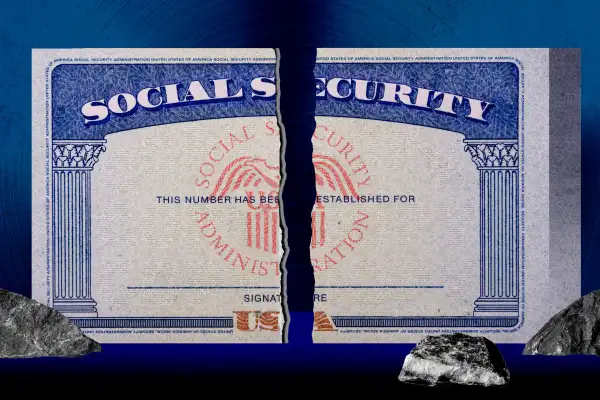Why So Many Americans Believe Social Security Is Going Away (Even Though It Isn’t)

Imagine that you’ve always wanted to go skydiving. You plan ahead, pay for the tickets and watch the safety lessons. But the moment you actually jump out of the plane, you have an awful realization: There's no parachute.
The fear of falling without something to catch you is shared by almost everyone, and it's actually reflective of how many Americans view Social Security.
A study released this week by Northwestern Mutual shows that 45% of Americans say they aren't confident Social Security will be there for them when they need it. A separate poll by Transamerica Institute found that 72% of respondents say they're worried the benefit program won't be around when they retire.
What's behind this? Are these concerns valid?
Whether it’s an immediate future or a distant goal, retirement is on lots of folks’ minds. Anxiety around funding retirement has persisted through recent economic tumult — and adding to it is a collective worry that Social Security will be going away, leaving the 67 million Americans who rely on its monthly payments high and dry.
The news cycle doesn't help. Doom and gloom headlines reign supreme when it comes to Social Security. Catherine Collinson, CEO and president of the Transamerica Institute, points to recent stories about how the Social Security coffers will soon run out as an example.
Created in 1935, Social Security is largely funded by payroll taxes paid by workers and employers. The money goes into two trust funds. One of these trust funds is responsible for disability benefits, and the other is responsible for retirement and survivor benefits.
But recent estimates now expect these combined funds to run dry by 2034, a year earlier than previously estimated. That means they won't be able to pay out 100% of benefits.
“Naturally, that’s cause for concern for everyone,” Collinson tells Money.
Reform is needed, she says. Two main courses would likely be taken by lawmakers, but both may be frustrating for workers. Under one proposal, payroll tax rates could be raised by 3.4 percentage points to nearly 16%. Under the other, the benefits themselves would get reduced by about 20%. As Collinson points out, this is a non-starter for many retirees already struggling with their declining purchasing power due to inflation.
“If somebody is living off a $1,700-a-month Social Security benefit, and that goes down by 20%, it reduces their benefit by $340 a month,” Collinson says. “And they're probably spread thin already living on $1,700 a month.”
Politics could decide the future of Social Security
Current political discourse is also informing many people’s ideas about the future of Social Security — or lack thereof.
Debt ceiling drama is the single biggest spectacle playing out on Capitol Hill right now. If Republicans and Democrats can’t agree on a way to raise the debt ceiling, the country could default on its bills.
Government-funded social programs like Social Security and Medicaid are likely the first to be affected from a scramble to fulfill the government’s fiscal obligations. As a result, a default could lead to a disruption or delay of Social Security payouts.
At the same time, there's been much talk among lawmakers around how to get the budget under control. Controversially, some politicians have suggested cutting public programs like Social Security and Medicare or raising the full retirement age as ways to bring down costs.
But it's unlikely that significant cuts will actually occur anytime soon, as changing Social Security could prove to be unpopular among voters — and 2024 is an election year.
But Social Security isn’t going away
Given the circumstances, it may seem that workers’ chances of a sound retirement are dubious. But there’s no reason to fear the Social Security program disappearing altogether.
“Social Security is not going bankrupt,” Collinson says. “The trust fund is a cushion to help ensure [the government] can pay benefit payments amid population fluctuations or payroll fluctuations ... it’s a buffer for instances in which there are more benefits being paid than payroll taxes coming in from today's workers.”
Of course, reducing benefits would mean even more hardship for retirees whose payments already continually fail to match inflation. However, as Collinson points out, there is a decade yet for lawmakers to think up and implement reforms that could minimize the consequences for beneficiaries.
And even were nothing to be done, the Social Security Administration wouldn’t cease to exist come 2034 — it would just decrease the benefits it can offer.
However, Collinson advises workers to utilize the tools available to them to stay on track for financial comfort in retirement. The SSA has a payment estimator to remove the guesswork of finding out how much one will need to budget to live comfortably in retirement. It’s important to set goals for savings based on estimated spending, she says, but also to stress test this plan under different scenarios.
“Keep tabs and pay attention to what potential reforms might look like,” she adds. “Knowledge is power.”
More from Money:
Americans Aren’t Saving Enough for Retirement — and All Taxpayers Might End up Paying for It
Social Security Recipients May Only Get a 3.1% Raise in 2024 Due to Lower Inflation
10 High-Yield Savings Accounts Offering 4.5% APY or More Now
